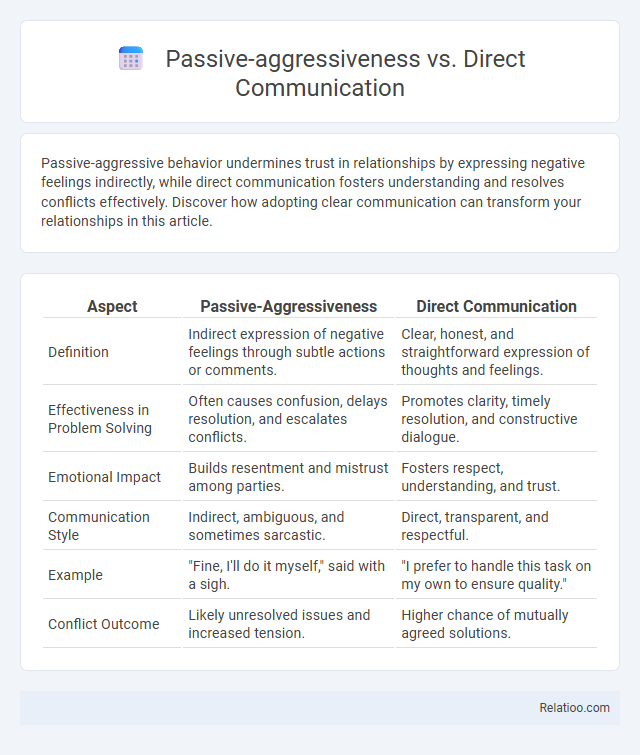Passive-aggressive behavior undermines trust in relationships by expressing negative feelings indirectly, while direct communication fosters understanding and resolves conflicts effectively. Discover how adopting clear communication can transform your relationships in this article.
Table of Comparison
| Aspect | Passive-Aggressiveness | Direct Communication |
|---|---|---|
| Definition | Indirect expression of negative feelings through subtle actions or comments. | Clear, honest, and straightforward expression of thoughts and feelings. |
| Effectiveness in Problem Solving | Often causes confusion, delays resolution, and escalates conflicts. | Promotes clarity, timely resolution, and constructive dialogue. |
| Emotional Impact | Builds resentment and mistrust among parties. | Fosters respect, understanding, and trust. |
| Communication Style | Indirect, ambiguous, and sometimes sarcastic. | Direct, transparent, and respectful. |
| Example | "Fine, I'll do it myself," said with a sigh. | "I prefer to handle this task on my own to ensure quality." |
| Conflict Outcome | Likely unresolved issues and increased tension. | Higher chance of mutually agreed solutions. |
Understanding Passive-Aggressiveness
Passive-aggressiveness manifests through indirect resistance and avoidance of open expression, often causing misunderstandings in communication. Direct communication involves clear, honest, and straightforward exchanges of thoughts and feelings, promoting transparency and resolving conflicts efficiently. Understanding passive-aggressiveness requires recognizing subtle behaviors such as sarcasm, procrastination, or silent treatment, which obstruct effective dialogue and damage trust in personal and professional relationships.
Defining Direct Communication
Direct communication involves expressing thoughts and feelings openly, clearly, and honestly without ambiguity, which fosters transparency and reduces misunderstandings. Unlike passive-aggressiveness, which masks true feelings behind indirect behaviors or sarcasm, direct communication promotes assertiveness and respect in interactions. This communication style enhances problem-solving and trust by encouraging straightforward dialogue and accountability.
Psychological Roots of Passive-Aggressive Behavior
Passive-aggressive behavior often stems from unresolved feelings of powerlessness, fear of confrontation, or low self-esteem, leading individuals to express hostility indirectly. In contrast, direct communication promotes psychological well-being by encouraging openness, assertiveness, and clear expression of emotions, reducing misunderstandings and emotional suppression. Understanding the psychological roots of passive-aggressiveness, such as avoidance of conflict and internalized anger, helps in developing healthier communication strategies that foster trust and emotional clarity.
Common Signs of Passive-Aggressiveness
Common signs of passive-aggressiveness include indirect resistance, sarcasm, subtle sabotage, and procrastination, often making it difficult to address conflicts openly. Unlike direct communication, which expresses thoughts and feelings clearly and honestly, passive-aggressiveness masks true emotions behind ambiguity and avoidance. Understanding these signs empowers you to recognize and respond effectively to passive-aggressive behavior in personal and professional interactions.
Benefits of Direct and Honest Communication
Direct and honest communication fosters trust and clarity in relationships by enabling you to express your needs and concerns openly without causing misunderstandings. Unlike passive-aggressiveness, which often leads to confusion and resentment, straightforward dialogue promotes healthy conflict resolution and emotional well-being. Embracing transparent communication strengthens connection and ensures your intentions are accurately understood.
Emotional Impact on Relationships
Passive-aggressiveness erodes trust and creates confusion in relationships by masking true feelings, leading to unresolved conflicts and emotional distance. Direct communication fosters transparency and emotional clarity, encouraging empathy and mutual understanding that strengthen relational bonds. Repeated passive-aggressive behavior intensifies resentment and emotional withdrawal, ultimately damaging intimacy and long-term connection.
Barriers to Direct Communication
Barriers to direct communication often stem from fear of conflict, lack of trust, or low self-esteem, causing passive-aggressiveness to surface as an indirect way to express dissatisfaction. When you avoid open dialogue, misunderstandings and resentment build, undermining relationships and teamwork. Overcoming these barriers requires cultivating emotional intelligence and fostering an environment of psychological safety where honest and transparent communication is encouraged.
How to Address Passive-Aggressive Tendencies
Addressing passive-aggressive tendencies involves recognizing indirect expressions of anger or resentment and encouraging open, assertive communication to replace hidden hostility. Building emotional awareness and fostering a safe environment for honest dialogue helps individuals express needs directly, reducing misunderstandings and conflicts. Implementing active listening techniques and setting clear boundaries further supports transforming passive-aggressive behaviors into constructive conversations.
Strategies for Fostering Direct Dialogue
Fostering direct dialogue requires establishing clear communication norms and encouraging open expression of thoughts and feelings without fear of judgment. Strategies include active listening, using "I" statements to express personal experiences, and providing constructive feedback that promotes mutual understanding. Training sessions on emotional intelligence and conflict resolution also help individuals move from passive-aggressive behaviors toward transparent and assertive interactions.
Choosing Assertiveness Over Passive-Aggressiveness
Choosing assertiveness over passive-aggressiveness enhances clarity and strengthens interpersonal relationships by promoting honest and respectful communication. Assertive communication directly addresses concerns without hostility, reducing misunderstandings and fostering problem-solving. Embracing assertiveness improves emotional health and collaboration, unlike passive-aggressiveness, which often leads to resentment and unresolved conflict.

Infographic: Passive-aggressiveness vs Direct Communication
 relatioo.com
relatioo.com